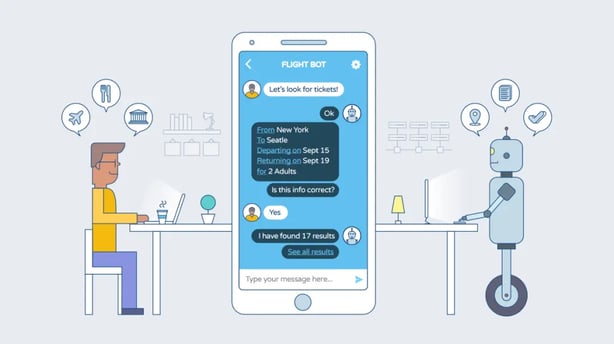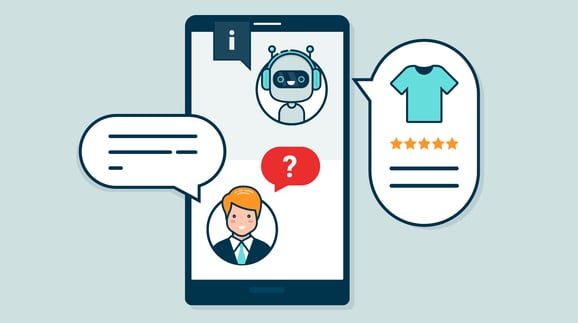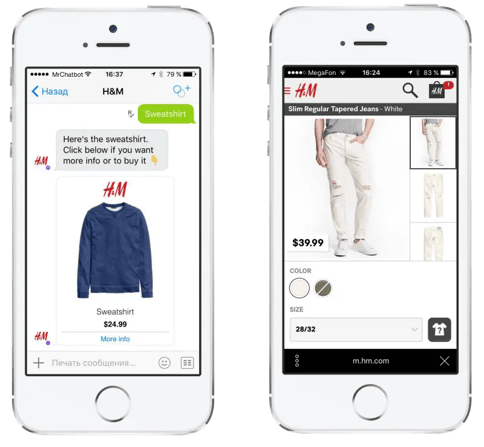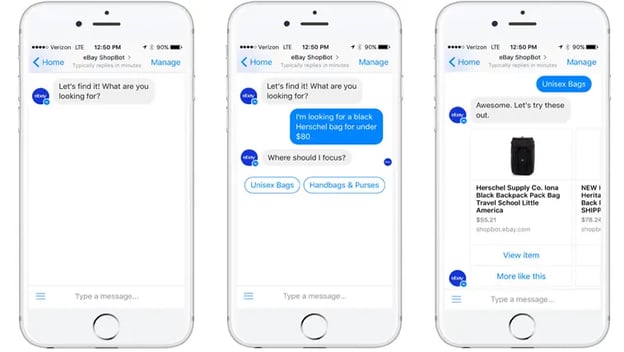Your Complete Guide On eCommerce Chatbots To Maximize Sales
According to Statista (2022), the global chatbot market accounted for 106$ million of revenues and will account for 455 million dollars in 2027.
This indicates the huge potential of e-commerce chatbots and how it transforms the shopping experiences of users. It does not only provide 24/7 customer service but also increases customer engagement, sales, and conversion rates.
To start your journey with e-commerce chatbots, we will take you through a complete guide on e-commerce chatbots, how to use them, why to use them, and examples of online stores using them.
Table Of Content:
- What is an eCommerce Chatbot?
- Why use an eCommerce Chatbot?
- How to use an eCommerce Chatbot?
- Examples of eCommerce Chatbot
What is an eCommerce Chatbot?
 Image source: emarketexperts.com
Image source: emarketexperts.com
An e-commerce chatbot is a computer program that online businesses integrate into their websites, messaging apps, and social media platforms to provide users with real-time, around-the-clock, automated customer service.
E-commerce chatbots are part of conversational marketing, which is a dialogue-driven marketing tactic that aims to facilitate sales and increase engagement. Accordingly, an e-commerce chatbot engages with customers at each stage of their buying journey.
Through witnessing chatbots incorporated in e-commerce stores, it will be apparent that there are different ways that these chatbots provide answers. Some might have certain formats of questions they only reply to, while others might answer questions as if they are real customer service representatives.
Therefore, there are three types of e-commerce chatbots:
- Rules-based chatbots: They are programmed to reply to only predetermined questions that might be asked by users. Thus, it has limited functionality, but it is considered a cost-effective option.
- AI-driven chatbots: They use AI tools known as natural language processing (NLP) to mimic human conversations and provide more engaging responses to customers' inquiries. This type of chatbot makes customers feel like they are talking with a real agent ( but it is not).
- Hybrid chatbots: This type of chatbot integrates the rules-based and the AI-driven. So, if customers have a simple question, the rules-based chatbot will reply. But, more complex questions will involve switching to AI-driven chatbots to reply.
Why Use an E-Commerce Chatbot?
After understanding e-commerce chatbots, it is necessary to tell you the reasons you should start integrating chatbots in your online store.
1- To Provide Customers With Instant Replies
 Image source: openphone.com
Image source: openphone.com
Generally, customers tend to talk and ask questions before completing a purchase. That’s the case for retail store shopping. However, in online shopping, customers’ tendency to talk is even more.
Through online shopping, customers have nothing but to see and ask about the products before purchasing to avoid any surprises.
So, long story short, talking and asking questions are integral aspects of the online shopping experience. Thus, you should always be there to reply to customers’ inquiries.
The thing is, buyers want immediate replies to their doubts, or you are risking losing them. Also, you don’t know the time when buyers might need to ask questions.
Therefore, the availability of a chatbot is essential to solve such an issue. E-commerce chatbots are available all day, every day, to instantly resolve any customer’s doubts.
2- Increase Sales
 Image source: ladder.io
Image source: ladder.io
One of the main reasons you should start including chatbots in your online store is the increase in sales.
There are plenty of ways chatbots can assist in increasing your sales:
- First, e-commerce chatbots will facilitate sales by providing information, responding to customers, and removing any of their doubts. Thus, customers will be more encouraged to start purchasing.
- Second, chatbots will offer personalized product recommendations. As a result, they will help in upselling and cross-selling relevant products.
- Third, e-commerce chatbots help in reducing one of the main issues facing any online store, which is cart abandonment. They send reminders to customers, announce discounts and sales, and engage with customers.
Accordingly, there is a high chance that customers will return to their “added to cart” products to finalize their purchases.
3- Provides After Sale Support
 Image source: hootsuite.com
Image source: hootsuite.com
The key to building trust and increasing customer loyalty is to provide superior after-sales support. In addition, you have to always be available to reply to customers’ queries post-purchase.
However, you won’t always be available to deal with customers’ concerns post-purchase. Accordingly, e-commerce chatbots come to the rescue to help build a strong, lasting relationship with your customers.
Chatbots reply to questions regarding shipping, returns, and refund policies. Thus, they offer a superior after-sale service that undoubtedly increases repeat purchase rates.
4- Increases Customer Engagement
 Image source: mastermessaging.com
Image source: mastermessaging.com
The main idea behind e-commerce chatbots is a customer-centric solution. Therefore, they offer instant replies to customers and provide them with the required information 24/7.
Accordingly, they are regarded as the optimal tool to increase customer engagement. They are keeping up with all customers' requirements every day, all day.
To benefit the most from chatbots, you can activate a pop-up message on each customer visit showing your help. This way, you don’t have to wait for customers to look for assistance as you are proactively offering it.
By all means, e-commerce chatbots are perfect for increasing customer engagement.
5- Saves Time And Reduces Costs
We are pretty sure that you have got it by now that an e-commerce chatbot is a spectacular tool for saving time and reducing costs.
In order to provide the service given by a chatbot, you have to hire several agents to respond to customers instantly across all platforms. Well, this will require a whole army and not only a bunch of agents.
Therefore, the cost of hiring agents is huge. So, in this case, sticking to a certain budget won’t be an option anymore. Yet, the presence of chatbots will provide superior customer service with minimum costs.
In addition, it will save you lots of time to focus on other tasks necessary for your online store; it is definitely a win-win.
How To Use an eCommerce Chatbot?
 Image source: ideainyou.com
Image source: ideainyou.com
At this point, you have to start considering incorporating chatbots into your e-commerce. Want to know how? This is exactly what we are going to take you through in the upcoming paragraphs.
1- Identify The Role Of Your Chatbot
The first thing you have to identify to start using your e-commerce chatbot is to identify its role.
For example, are you intending to use chatbots to reply to visitors’ questions or provide post-purchase assistance or general support? Also, you will have to decide if the chatbot will be present on your website or on your social media platforms.
All of these aspects will act as a guide to the suitable type of chatbot to use.
2- Determine Your Goals
Your goals should always be the framework for your actions. Therefore, you have to determine your goals behind incorporating chatbots in your online store.
Are you aiming to reduce cart abandonment rates and increase sales, leads, and conversion rates? By determining your goals, you will be able to assess the success of your chatbots and pinpoint any weaknesses to be considered.
3- Research To Choose The Suitable Chatbot
As soon as you have identified your goals and the role of your chatbot, you are now ready to start searching for a suitable chatbot.
There are plenty of options available to choose from. Thus, decide if you will rely on rules-based or AI chatbots. Also, determine the allocated costs and the way through which chatbots are integrated into your store.
As a result, you will identify the optimal type of chatbot suitable to your e-commerce and will be ready to install it.
4- Evaluate The Results
To make sure you are on the right track, you will have to evaluate the results of incorporating an e-commerce chatbot.
Measure customer engagement, conversion rates, and sales. Hence, you will be able to evaluate the results compared to your goals and identify points to be changed.
For instance, you might change replies or messages to provide an enhanced user experience.
Examples Of eCommerce Chatbot
Need some inspiration? We have got you covered as we will take you through various examples of e-commerce chatbots to start getting things done.
- H&M
 Image source:clickz.com
Image source:clickz.com
H&M is killing it by using e-commerce chatbots. The multinational clothing company uses a chatbot through which it acts as a virtual stylist to offer online shoppers a perfect shopping experience.
The bot starts by offering users two options of different outfits to choose from. Based on visitors’ choices, they are offered personalized outfits with all the product details and prices. By clicking on the products, users are directed to the H&M website to complete their purchases.
Additionally, the H&M chatbot provides users with around-the-clock customer service to instantly reply to any of their concerns.
Therefore, the usage of e-commerce chatbots was able to facilitate the sales process while increasing conversion rates.
- Sephora
 Image source: fastcompany.com
Image source: fastcompany.com
Sephora is taking e-commerce chatbots to a whole other level.
It incorporates two types of chatbots in its Facebook messenger platform. First, the reservation assistant helps customers make appointments with beauty specialists at any of Sephora’s stores. All the customer has to do is mention her place, and the chatbot will provide her with the nearest store and the available timings.
Second, Sephora offers a virtual artist type of chatbot. It allows users to try different shades to identify the suitable one. Thus, customers need to upload their pictures to the chatbot, and the bot will rely on AI to provide visitors with the best shades.
- eBay
 Image source: ebayinc.com
Image source: ebayinc.com
eBay decided to benefit the most from chatbots by creating its virtual shopping assistant.
Through eBay’s chatbot, users can mention keywords of products they are looking for, and the bot will offer related products. Or, visitors might upload pictures of a desired product, and the bot will offer them similar ones.
Additionally, the chatbot on eBay provides customers with product recommendations compatible with their previous purchases. Thus, it aims to provide a seamless shopping experience to users.
 By
By


